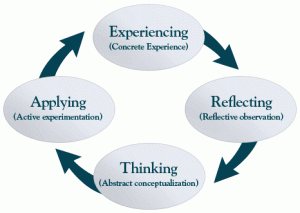What’s in it for me?
Thinking back to August, and our professional development (PD) day, I have been thinking about our aim for a more experiential learning environment (Kolb’s learning theory).
Comments overheard during PD included lots of examples of experiences we are providing students to actively engage them in this process of learning, but all too often the buck stops there.
Recent years have seen that push for active learning and, much to student dismay, we have pressed on with group projects, role playing, student teaching, etc., “forcing” students to engage in their learning. This has often resulted in their frustration and has been reflected on evaluations.
We must remember that hands-on does not automatically mean minds-on.
David Kolb’s theory of experiential learning includes moving beyond the doing.

Figure 1. Kolb and Fry’s Learning Process: http://hrcouncil.ca/hr-toolkit/learning-understanding.cfm
Experiential learning takes this active learning process to the next level and tries (almost requires) students to invest in the experience…. and you thought generating faculty buy-in was tough.
The concrete experiences we provide, offer an emotional dimension to the learning experience, which can be uncomfortable for both students and ourselves.
Our role as educators is to help them see (and eventually value) its purpose.
At a recent nursing conference, presenter Tim Bristol PhD, RN, CNE, ANEF explained this best as something he calls the “what’s in it for me” connection.
“Why is this learning experience important to me as a student?”
“Will this be on the test?”
“Do I need this information in the future or in my everyday life?”
In addition to taking our active learning experiences to the next level of experiential learning, we need to take this “why” and make it about them.
Be up front with students when reviewing syllabus or specific experiences: This is what we are doing, this is why we are doing it, and one step further…this is what is in it for them. Will it make them a better student or better nurse, help them land the better job in a competitive market, and/or allow them to achieve an understanding that helps them reach the next level and beyond.
We also cannot forget to connect the dots. The steps of reflection and application are all too often the steps we neglect, and this is where crucial learning can be pulled from the experience. What was learned and what was not, from the perspective of the students, (not how they did on your test/exam). What do we do with this new information?
Having reflective discussions or activities with students and analyzing their experience as a deliberate part of the experience itself, can give educators a link to outcome measurement. So there is a little something in it for us too.

